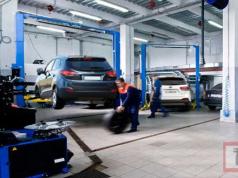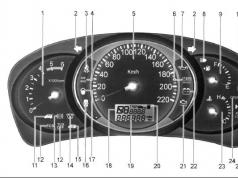Remember the importance of regular checks brake system... Most drivers check the brakes when there is already a problem, therefore brake discs, pads and other components of the braking system have not been inspected in a timely manner.
Present to your attention short review major problems with the braking system:
Low brake fluid level
Usually indicates a leak in the brake system, which can lead to very serious consequences. It is necessary to check the calipers, brake hoses and pipes, the brake master cylinder. If a leak is found, the defective component must be replaced with a new one. The car must not be driven until it has been repaired, as a leak can lead to complete brake failure.
The brake pedal is at the very bottom
This can happen on drum brakes if the adjusters are jammed to compensate for the normal wear of the working material of the pads. The adjustment can restore the pedal to a normal level, but the problem will recur as the pads wear further. It is recommended that you clean the regulators well or replace them with new ones. Also, worn brake hoses or leaks can be the cause of a low brake pedal. brake fluid.
Soft or wadded brake pedal
Means that there are air bubbles in the brake system, which got there during improper bleeding of the brakes or when there is a leak or very low level of brake fluid. It is necessary to bleed the brakes in the sequence that is intended for this car model. Another reason could be worn out rubber brake hoses that “inflate” when braking.
Large pedal free travel
Possible causes: Worn brake hoses, improperly adjusted drum brakes, or air in the system. This symptom is quite dangerous, as the car can completely lose the brakes even before a safe stop.
The pedal falls into the floor
A very dangerous situation caused by severe wear of the oil seals in the brake master cylinder or leakage in hydraulic system which prevents the brakes from holding pressure.
Brake pedal runout
Indicates a curved disc - needs to be replaced or re-machined. The working surfaces should be flat (no more than 0.05 mm of runout) and should be parallel (within 0.0127 mm for most vehicles). Also don't forget about wheel bearings- if they are serviceable, they must be cleaned, checked and re-sealed with grease. You will also need new wheel bearing seals.
Scraping noise
Usually indicates that metal is rubbing against metal and you are facing a major unplanned brake system repair. Replacement will most likely be required brake discs and / or drums, as well as repair or replacement of other parts of the brake system (hoses, caliper guides). Some disc brake pads have special metal wear indicators that make this sound. This means that the brake pads are already in need of replacement.
Squeal or squeak
Usually caused by vibration between disc pads and caliper. It is treated by replacing or grooving brake discs, installing new pads or applying a special anti-noise compound to the rear surfaces of the pads.
Rattling
Usually caused by installing improperly routed discs.
Seizing the brakes
Oil, grease or brake fluid on the pads can cause the brakes to "stick". Find and eliminate the cause of the contamination and replace the pads. Can also pick up drums or discs with deep scratches, a groove or replacement may be necessary.
Wedging brakes
May lead to vehicle drift to one side and / or increased fuel consumption. May be caused by loose or broken springs in drum brakes, wedging of a rusty or worn guide in a caliper, wedging of a cylinder in a caliper, improper adjustment of wear compensators in drums, or jammed or frozen cables hand brake... It is necessary to rebuild the calipers every 60,000 km (uneven wear of the inner and outer pads can serve as a signal for such a bulkhead).
Driving the car to the side when braking
It can be caused by: dirty pads, improper brake adjustment, broken cylinder or the entire caliper, wedging brakes on one side, uneven wear brake discs on the sides of the vehicle or worn wheel bearings.
Hard ("oak") brake pedal
Insufficient vacuum boost can be caused by a low manifold vacuum, a leak in the vacuum tube of the brake booster, or a defect in the booster itself. Sometimes, a broken check valve will leak vacuum from the brake booster and result in a stiff brake pedal. Diagnostic procedure: bleed the vacuum from the system with the engine off, start the engine with the brake pedal depressed - if the pedal is "gone", then the amplifier is in order. If the pedal remains stiff when starting the engine, pay attention to the amplifier, amplifier vacuum tube and check valve.
On vehicles equipped with the Hydroboost system, a stiff pedal can result from a stretched power steering belt, low fluid levels, leaks in the hydraulic pipes, or broken valves in the Hydroboost itself.
These problems, especially brake fluid leakage, are especially critical these days, since the vast majority modern cars equipped with ABS system... This system is a complex combination of electrical and hydraulic components that cannot withstand moisture or corrosion.
Brake fluid
Brake fluid is highly hygroscopic, which means it easily absorbs water (moisture). When moisture is absorbed, the boiling point of the liquid is significantly reduced, it boils much earlier and the brake system fails. The fluid must be changed every 2 years or 60,000 km.
In my article today I want to talk about brake pedal, namely, what it should be, ideally, tight or, on the contrary, soft, how to find this golden mean?
By and large brake pedal can have several positions and states.
The first state is the one provided by the manufacturer, when when you click on brake pedal there are no failures, no jerks, and no special effort is required. There are also two other unpleasant pedal conditions for the driver that can cause anxiety in the driver.
This refers to the state of the pedal when it is excessively tight or, on the contrary, very soft. Both the one and the second phenomenon are equally unacceptable and indicate malfunctions and the need for urgent repair of the brake system.
Tight brake pedal can be for several reasons, and they may not necessarily be associated with traditional "sores" that are typical for all models of brakes. However, I still propose to consider the most common of them, and also try to give practical advice on how to eliminate them.
2. Sticking of the valve body in the vacuum booster. It is necessary to replace the vacuum amplifier;
3. The diaphragm of the vacuum booster is damaged. It is solved by replacing the vacuum amplifier;
4. Defective tip vacuum amplifier. The tip should be replaced;
5. Sticking or non-operation of the check valve in the vacuum booster. To eliminate, it is necessary to replace the check valve;
6. The check valve of the vacuum amplifier is faulty or the tightness is broken, as a result of which fuel enters the chamber of the vacuum amplifier. The vacuum booster with a non-return valve should be replaced;
7. Damage to the hose that connects the vacuum booster and the intake manifold, or the hose is loose on the fitting. It is treated by replacing the hose, or, if possible, by tightening the fastening clamp. The condition of the hose should be monitored regularly, especially in the cold season. As long as the hose is cold, it retains the required rigidity - the brakes function normally. However, after several tens of minutes of running the motor, the hose heats up and becomes more elastic. If, for example, during inspection you did not find delamination, the throughput of the hose will decrease, which in turn can cause problems with the brake pedal.
8. O-rings in the working wheel cylinders are swollen, this often happens as a result of the ingress of fuel and lubricants on their surface, or as a result of the use of low-quality brake fluid. To remedy this situation, it is necessary to repair the working brake cylinders, and replace the brake fluid.
Here are some ways how to independently check the performance of a vacuum amplifier.
First of all, do it in order for a vacuum to occur in the system. After that, press the brake pedal if the pedal is stiff - this is a clear sign of a hose or amplifier malfunction. Then turn off the engine and wait 5-7 minutes, do not apply the brakes.
It is necessary to concretize the malfunction, for this press the pedal. If it is still tough - most likely, the malfunction lies in the valve of the vacuum booster.
There is also another test. At idle engine, it is necessary to depress the brake pedal several times in order to remove the vacuum in the brake system. After that, without releasing the pedal, it is necessary to start the engine, if the pedal starts to go down a little - the amplifier is in order.
Cause of soft brakes
A soft brake pedal, as a rule, indicates several breakdowns in the brake system at the same time. More precisely, there are many reasons why the brake pedal can become soft. Sometimes this phenomenon is also called brake pedal failure.
The brake system of Gazelle cars is two-circuit with a hydraulic drive. The first circuit includes front disc brakes, and the rear circuit consists of two drum brake mechanisms and a brake force regulator ("sorcerer"). Malfunctions in the braking system can occur due to the poor quality of individual components and improper actions of the driver when performing renovation works brake system.
One of the "diseases" of the Gazelle brakes is the actuation of the brake drive from the second pitch. The culprit for this malfunction is the piston thrust rings located in the rear brake cylinders. Due to the low quality of their manufacture, they lose their elasticity during the operation of the car, as a result of which the clamping spring of the pads moves them together with the piston to the middle of the cylinder. In this case, the gap between brake pads and the brake drum and one pressing of the brake pedal is not enough for the pads to press against brake drum... Therefore, the driver has to press the brake pedal a second time.
If the brakes are triggered only after several presses on the brake pedal, then this will not indicate the tightness of the hydraulic drive, but the place of the brake fluid flowing out of it is occupied by air. Before you start pumping the hydraulic drive, you need to find the place of the brake fluid leakage and eliminate it. You need to start removing air from the system from the right rear brake cylinder, then the left rear, right front and finish with the front left.
If you are not the first owner of a Gazelle car, and if air enters hydraulic drive you can not pump it in any way. Then pay attention to the front brake calipers. It is possible that during the repair of the brake system, the calipers were reversed, installing the right one instead of the left one, and the left one instead of the right one. In this case, the valves by means of which the air is removed will be located at the bottom and when pumping, it will not be possible to remove air from the caliper. To eliminate this malfunction, you will have to rearrange the calipers so that the valves are at the top.
The master cylinder can also be the culprit for the failure of the brake system. You can check the correctness of its functioning as follows. To identify its malfunction, you need another person who will press the brake pedal. And you, at this time, must unscrew the lid of the feed tank, where the brake fluid is located, and see if it gushes when you press the brake pedal. If so, the brake master cylinder will need to be replaced.







